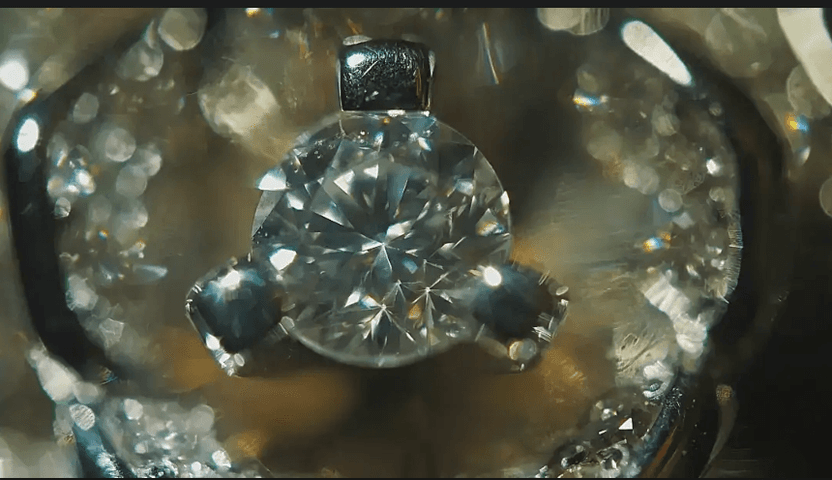White Sapphire vs Moissanite: Best Picks for Your Engagement Ring
Posted by Eddie R on Oct 24th 2024
White sapphire vs moissanite: How do they compare? We break down their sparkle, durability, and cost so you can choose the right gemstone for your engagement ring.
Key Takeaways
- White sapphires are natural gemstones known for their durability and affordability, while moissanite is a lab-created stone recognized for its exceptional brilliance and fire.
- Moissanite exhibits a higher refractive index and fewer inclusions than white sapphires, resulting in a more dazzling appearance, but white sapphires are often more budget-friendly.
Understanding White Sapphire
White sapphires, members of the corundum family, form beneath the Earth’s surface under extreme heat and pressure. Composed of aluminum oxide, these natural gemstones are celebrated for their brilliance, durability, and affordability compared to traditional diamonds.
What is White Sapphire?
White sapphire, a natural form of corundum, is recognized for its colorless beauty and classic appeal. Unlike their blue counterparts, white sapphires do not display the vivid hues typically associated with sapphires, making them a subtle yet elegant choice for jewelry.
This colorless natural gemstone is valued for its understated elegance, offering versatility in any jewelry collection. It provides a high-quality, affordable diamond alternative to traditional diamonds and features gem quality stones.
Characteristics of White Sapphire
White sapphire boasts a refractive index of 1.77, contributing to its brilliance and ability to reflect light beautifully. However, its fire, or the dispersion of light into various colors, is less pronounced than that of diamonds and moissanite. Despite this, white sapphire remains a visually appealing choice for those who appreciate a more subtle sparkle.
In terms of durability, white sapphire ranks 9 on the Mohs scale, making it one of the hardest gemstones available. This hardness ensures white sapphires can withstand daily wear without significant scratching or damage, making them an excellent option for engagement rings and other frequently worn jewelry.
While primarily colorless, white sapphires and blue sapphires can exhibit subtle tints of gray or blue. These variations, along with their association with healing energy in alternative healing practices, add to their unique charm and appeal.
Exploring Moissanite
Moissanite has become a popular choice for moissanite engagement rings, offering a dazzling alternative to traditional diamonds. Known for its exceptional brilliance and affordability, moissanite stands out as a top contender among diamond alternatives.
What is Moissanite?
Moissanite is a lab-created gemstone made from silicon carbide, a material known for its exceptional hardness and brilliance. Originally discovered in a meteor crater, moissanite’s rare natural form is now synthetically produced to meet the demands of jewelry enthusiasts seeking a stunning yet budget-friendly option.
Renowned for its fiery sparkle, moissanite comes in various color grades, setting it apart from white sapphires. Its unique traits make it a sought-after choice for a diamond-like appearance at a lower cost.
Characteristics of Moissanite
Moissanite’s high refractive index, surpassing even diamonds, leads to exceptional brilliance and fire. This light-reflecting quality creates a vibrant, dazzling display.
Moissanite is typically eye-clean, with minimal visible inclusions. However, it can show slight yellow or green tints under certain lighting conditions, adding a unique touch.
Its durability is another key feature. With a hardness rating of 9.25 on the Mohs scale, moissanite is an excellent choice for daily wear, as it can withstand scratches and maintain its brilliance over time.
Comparing White Sapphire and Moissanite
When deciding between white sapphire and moissanite, it’s important to consider their unique qualities and how they fit your style and needs. Both are popular diamond alternatives, but moissanite offers distinct advantages, making it the preferred choice for many, especially in engagement rings and fine jewelry.
Brilliance and Fire
If you are looking for maximum sparkle, moissanite is hard to beat. Thanks to its higher refractive index, moissanite reflects light more brilliantly than white sapphire, resulting in an intense sparkle that catches the eye.
When it comes to fire—the gemstone’s ability to disperse light into a rainbow of colors—moissanite also excels, outshining white sapphire with its vivid flashes of color.
White sapphire offers a lovely, silvery shine but lacks the vibrant, rainbow effect that moissanite delivers. If dazzling brilliance and fire are top priorities for you, moissanite is the clear winner.
Durability and Hardness
Durability is key for everyday wear, and both gemstones hold up well. White sapphire has a hardness rating of 9 on the Mohs scale, making it a tough and scratch-resistant choice. However, moissanite goes a step further with a rating of 9.25, offering even better scratch resistance and long-lasting brilliance.
For those who want a gemstone that can endure daily wear with minimal upkeep, moissanite's superior hardness makes it the more durable and worry-free option.
Color and Clarity
Moissanite is available in both colorless and near-colorless varieties, giving you flexibility in appearance, while white sapphire may have slight gray or blue tints, adding a subtle uniqueness to each stone.
In terms of clarity, moissanite often has fewer visible inclusions, resulting in a cleaner, more flawless look. White sapphires, being natural stones, may have tiny imperfections, but these can add to their charm. For a crystal-clear appearance, though, moissanite stands out.
Price and Affordability
White sapphire is typically more affordable, making it an appealing option for those looking for budget-friendly elegance. However, moissanite, though slightly more expensive than sapphire, is still very affordable and offers greater value in the long run due to its superior brilliance, fire, and durability.
If you are looking for a gemstone that provides lasting beauty and high visual impact, the investment in moissanite is worth every penny.
Ethical Considerations and Sustainability
Ethical considerations play a significant role in choosing between white sapphire and moissanite. The mining of white sapphire raises environmental and ethical concerns, while lab-created moissanite offers a more eco-friendly alternative.
Mined vs Lab-Created
Mined gemstones like white sapphire can lead to habitat destruction and community displacement. In contrast, lab-created moissanite is produced in controlled environments, ensuring ethical practices and reducing environmental impact.
Choosing lab-created moissanite over mined white sapphire can mitigate the ethical issues associated with gemstone mining. This makes moissanite a transparent and responsible choice for environmentally conscious consumers.
Sustainability
The production of lab-grown moissanite significantly reduces resource use compared to traditional mining methods. This results in a smaller carbon footprint, making moissanite a more sustainable option.
Considering the environmental impact, lab-grown moissanite offers a more sustainable choice over mined white sapphire.
Choosing the Right Gemstone for Your Engagement Ring
Selecting the right gemstone for your engagement ring involves balancing personal preferences, ethical considerations, and practical needs. Both white sapphire and moissanite offer unique advantages that cater to different tastes and priorities.
Personal Preference
Choosing between white sapphire and moissanite often comes down to personal preference. Some favor the understated elegance and natural origin of white sapphires, while others prefer moissanite for its brilliance and environmental benefits.
Factors like brilliance, fire, color, and price play a role in your decision. Maintenance requirements and environmental impact also influence your choice.
Purpose and Use
Moissanite is often preferred for daily wear due to its durability and lower maintenance. Its long-lasting brilliance makes it practical for engagement rings.
White sapphire, though beautiful, may need more frequent cleaning and is better for special occasions. Daily wear can lead to a frosted appearance, diminishing its initial brilliance.
Choose Harlem Bling for Your Radiant Engagement Rings
At Harlem Bling, we know that your engagement ring should be as unique as your love story. That’s why we offer a stunning range of moissanite jewelry that rivals the brilliance and quality of diamonds, all at an affordable price. Our expertly crafted pieces are designed to shine just as bright as your special moments. Moissanite’s durability and fire make it the perfect choice, especially when you are seeking elegance with a modern touch, ensuring that your ring will stand the test of time—just like your love.
When you shop with Harlem Bling, you are not only getting access to our extensive collection of over 3,000 stunning jewelry pieces, but you are also choosing quality and reliability. Plus, with flexible financing options like Sezzle and Afterpay, you can buy now and pay later, making it easier than ever to get the ring of your dreams.
Why settle for the ordinary when you can have the extraordinary? Whether you are looking for an engagement ring or a unique piece to add to your collection, our commitment to quality, affordable prices, and top-notch customer service makes us the clear choice.
Shop Harlem Bling today.
Conclusion
Both white sapphire and moissanite are excellent alternatives to traditional diamonds, each offering unique benefits. White sapphire’s subtle elegance and natural origin contrast with moissanite’s exceptional brilliance and ethical advantages. Ultimately, the choice depends on personal preferences, ethical considerations, and practical needs.
Whether you choose the understated charm of white sapphire or the dazzling sparkle of moissanite, both gemstones can provide a stunning centerpiece for your engagement ring. Make an informed decision, and let your chosen gemstone beautifully reflect your love story.
Frequently Asked Questions
1: What are the main differences between white sapphire and moissanite?
The primary distinctions between white sapphire and moissanite are their chemical composition and brilliance; white sapphire is a natural gemstone with lower sparkle, while moissanite is lab-created and exhibits exceptional brilliance. Consequently, moissanite typically shines brighter and appears more vibrant than white sapphire.
2: Which gemstone is more durable, white sapphire or moissanite?
Moissanite is more durable than white sapphire, with a Mohs hardness rating of 9.25 compared to white sapphire's 9, making it more resistant to scratches and ideal for everyday wear.
3: Is moissanite more expensive than white sapphire?
Moissanite is generally more expensive than white sapphire, but its superior brilliance and durability justify the higher cost.

